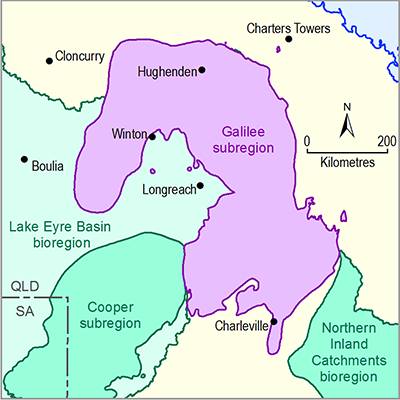Summary
The Galilee subregion has a high diversity of ecological communities and species as a consequence of the interactions between its large area, several biologically significant climatic gradients, the biogeographic effects of eight river basins, and the importance of landscape form driving water and soil redistribution in semi-arid environments of inland Australia. This diversity is expressed through the presence of 31 subregions of the Interim Biogeographic Regionalisation for Australia (IBRA; Department of the Environment, 2014a) and 46 major vegetation subgroups of the National Vegetation Information System (NVIS; Department of the Environment, 2014b). Pastoral grazing is by far the most frequent land use (>95%) and conservation reserves occupy around 3%.
The most common terrestrial vegetation NVIS subgroups are (i) Mitchell grass (Astrebla) tussock grasslands, (ii) Eucalyptus open woodlands with a grassy understorey, and (iii) cleared, non-native vegetation. Other vegetation subgroups occur with lower frequency and form a complex mosaic that gradually changes from north-east to south-west across the subregion. The woody components of these vegetation types have been subject to clearance over 16% of the subregion, mainly to the east, with the aim of improving pasture productivity. The annual rate of clearance has declined since 2005. Pasture components are reported to have stable condition, except for a recent decline in the north-east corner.
Wetlands listed formally in A directory of important wetlands in Australia (DIWA; Department of the Environment, 2014c) occupy 0.3% of the area of the Galilee subregion, and riverine floodplains that are also potentially water dependent occupy a further 15.5% of the area.
As rivers and streams are all intermittent, the durations of flow and non-flow periods, and the depth of water, together determine the number of species locally per unit area and degree of species sharing amongst rivers and residual waterholes. The ecology of rockholes (shallow depressions that collect local rainwater) and outcrop springs (springs of water that has percolated through rock layers in the immediately surrounding area) is poorly studied, as is the ecology of the species that occur within aquifers below ground level (stygobiota). However, discharge springs (springs of water that had percolated through rock layers over long distances and from which water emanates under pressure) are better studied, and numerous locally endemic species of plant, mollusc and fish have been identified. The ecology of both discharge springs and stygobiota is understood to depend on relatively stable water regimes, compared with the highly intermittent character of other aquatic habitats in the region. As a result of water drawdown for agriculture, discharge springs have been subject to significant degradation over the last century. Only 36% of the 300 springs complexes (local clusters of springs) identified in the Great Artesian Basin in 1900 are still active. There are no data on impacts of agricultural drawdown on stygobiota. Discharge springs have also been subject to invasion by exotic plants and disturbance by sheep, pigs, horses and donkeys. Riverbanks and waterholes are generally assessed to be in better condition.
In the Galilee subregion, 38 species and seven ecological communities are listed nationally under the Commonwealth’s Environment Protection and Biodiversity Conservation Act 1999, of which 15 species and two ecological communities are water-dependent beyond incident rainfall: (i) the community of native species dependent on natural discharge of groundwater from the Great Artesian Basin and (ii) the Coolibah - Black Box Woodlands of the IBRA Darling Riverine Plains and the Brigalow Belt South bioregions. A further 102 species are listed under Queensland’s Nature Conservation Act 1992.

